Substation Design Complexity
Substation design is a very complex process that involves many professional engineers in many different areas. However, there are always few people who are leading the whole design process both from the technical and economical aspects. This technical article covers the selection of substation type (GIS or Air-insulated) and the detailed design of Air-insulated Substation.
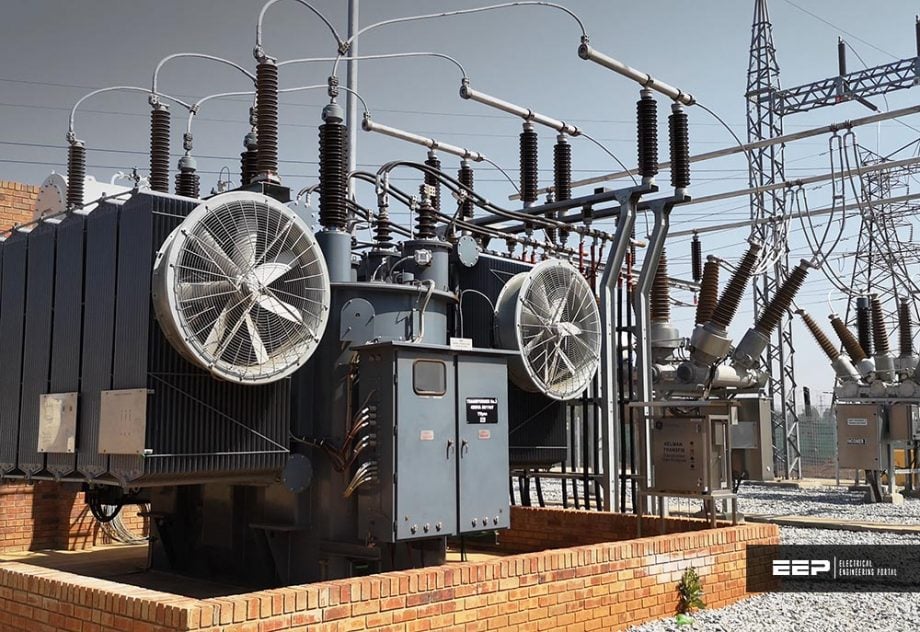
Many nations have their own safety rules and, because of their importance and legality as considered at the beginning of this article. The three component parts of the substation are defined as follows: Primary, Secondary, and Auxiliary System.
Let’s remind ourselves of these three basic substation systems:
- Primary System: The primary system comprises all equipment that, in whole or in part, is in service at the highest operating voltage of the system.
- Secondary System: The secondary system comprises all equipment that is used for the control (local and remote), protection, monitoring automation and measurement of the primary system.
- Auxiliary System: Auxiliary systems are those which are required to enable the primary and secondary equipment to operate.
- Selection Of Substation Type (GIS/AIS)
- Choosing Substation Layout:
- General Criteria and Rules:
- Safety Rules – Definitions
- Overvoltage and Insulation Levels
- Current Rating and Overcurrents
- Electrical Clearances
- Mechanical Forces:
1. Selection Of Substation Type (GIS/AIS)
The selection of substation type is, in most cases, largely dependent upon economic factors. As far as HV equipment is concerned an air-insulated substation costs less than an equivalent in GIS, but, as GIS allows a much wider choice of site, the distance to the load centre, site preparation costs and reduced maintenance costs may balance the difference.
In recent years reduction of the HV equipment price gap and increasing pollution and environmental concerns have made GIS more attractive. As a consequence, air-insulated, indoor, HV substations are not installed at voltages above 145 kV.
That makes them a good solution in cases of:
- Urban areas: High land cost and unavailability of required area for an air-insulated substation.
- Mountainous zones: High site preparation costs.
- Environmental concerns: GIS can be easily disguised and indoor (or, exceptionally, underground) installed if necessary. It should he noted, however, that it is not always possible for incoming feeders to be overhead lines.
- Very high pollution levels: GIS phase-to-phase and phase-to-ground insulations are not affected by pollution, but the metallic envelopes may suffer from corrosion problems in harsh environments. in case of outdoor GIS substations.
- Altitude above 1000 m: The internal GIS insulation is independent of atmospheric pressure, so the need for special insulators is limited to the bushings.
- Uprating, refurbishment or replacement of air-insulated substations in restricted areas.
The disadvantages of GIS substations are that the small area occupied can lead to difficulties concerning maximum step and touch voltages, so earth conductors may have to be extended beyond the substation limits (IEEE 80).
If possible, HV equipment in a GIS must be compatible, and extensions and replacements for the next 20 or 30 years must be considered at the time the initial order is placed. That’s what we call a good planning!
Suggested reading – Mastering GIS control circuits: AC/DC auxiliary circuits and circuit breaker closing circuit
Mastering GIS control circuits: AC/DC auxiliary circuits and circuit breaker closing circuit
Go back to the Contents Table ↑
2. Substation Layout
Although it is impossible to supply construction details for various types of layouts corresponding to a given bus bar scheme, it is advisable to suggest a few general guidelines with reference to the more usual design situations.
2.1. Primary Circuit
Layouts with conductors disposition with only two-level are preferred, e.g.: the upper for the bus-bars system, the lower for the switchgear connections. See Figure 1 and notes on the solutions employing rigid or flexible conductors.
Figure 1 – AC substation with flexible or rigid conductor
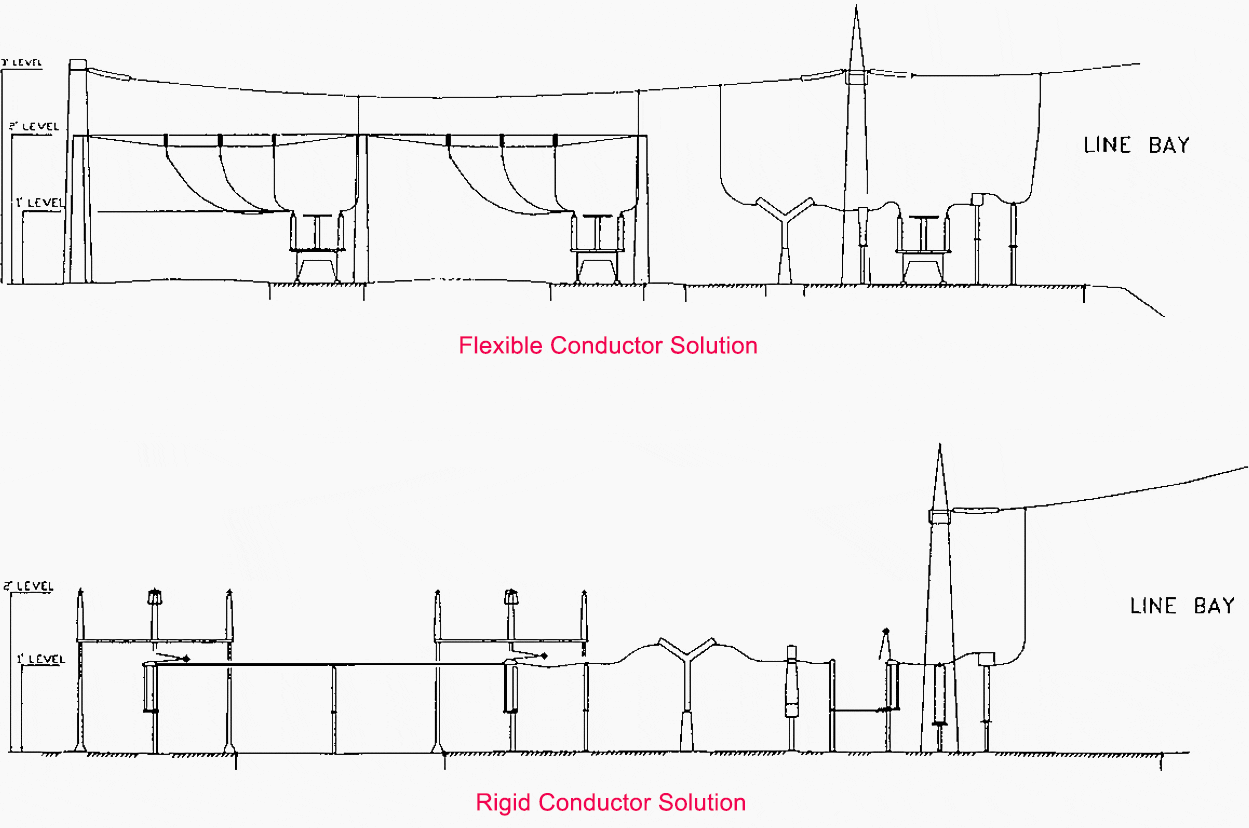

Heavy components, such as circuit breakers and measuring transformers should be installed in line and on the side of appropriate routes for mounting, dismounting and maintenance. Usually, the maintenance should be carried out by means of equipped vehicles. In this case, it is very important to fix the width of the route and its distance from the bay taking into account the safety distances between the operator handling work tools and the live parts.
See Figure 2.
Figure 2 – Safety distances in AC substation
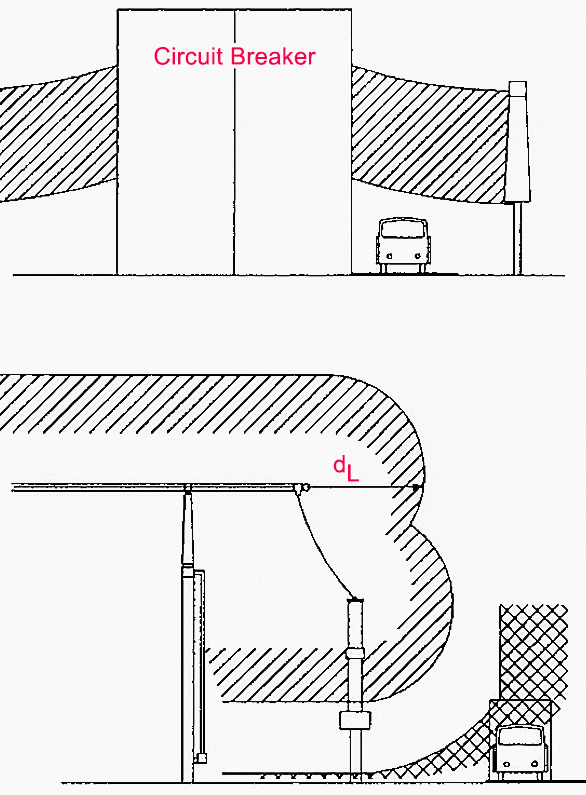

In order to avoid long service interruptions due to clamps or conductors failures, it is advisable that energy conductors or earth wires span do not overpass more than one busbars system, See Figure 3.
Figure 3 – Overpass with two spans


A good solution is, when possible, the adoption of line-bays on both sides of the substation. See Figure 4.
Figure 4 – Arrangements of circuit breakers (a) With circuit breakers at one side of the substation; (b) With circuit breakers at both sides of the substation


Line and transformer bays sequence should, if possible, be fixed minimising the possibility of overloading busbars or connection conductors.
It is necessary to consider in the layout design, the possibility of extension of the substation. This topic is more important in the case of substations with ring scheme busbars. A particular design allows for an easy transformation from a ring scheme to a double busbar with a 1 ½ circuit-breaker scheme.
See Figure 5.
Figure 5 – Mesh arrangement
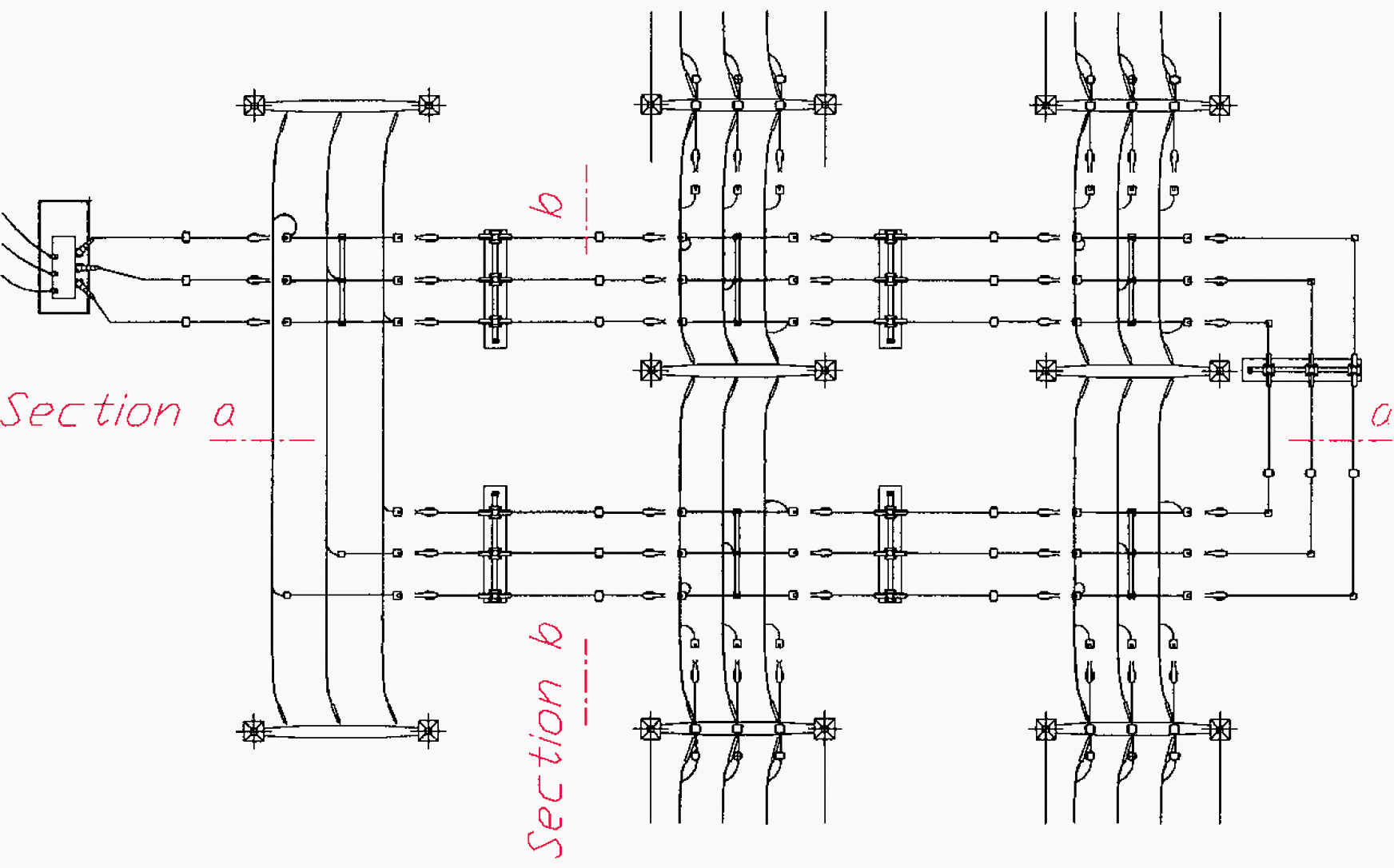

Lightning protection is necessary to protect a substation against direct lightning strokes. This protection can be arranged in either overhead earth wires or lightning rods. It is easier to get an efficient protection bay using earth wires.
Special attention has to be paid to the elimination of the risk of earth wire fall down on the switchgear.
Go back to the Contents Table ↑
2.2. Secondary Circuit
In order to minimise the electromagnetic interference between primary circuit and control equipment and for economic reasons (especially when cables are employed), an alternative is to decentralise the control, protection and automation apparatus.
In Figure 6, a disposition example of secondary circuits concerning control and protection systems is illustrated, taking into account the technology trends regarding energy management systems.
Figure 6 – Mesh arrangement, Section a (see Figure 7)


Go back to the Contents Table ↑
2.3. Criteria for the Choice between Rigid or Flexible Conductor
At present, the substation design with voltage level up to 500kV, rigid conductors is preferred as it is more simple and economic. In this case, aluminium alloy tubes are employed. For higher voltage levels, it can cause more difficulty to set up by tube bundle conductors with an equivalent diameter suitable to contain the corona effect to an acceptable limit.
Of course, the choice of the best solution is influenced by the availability of materials that change from country to country, and by different company experiences.
In the following paragraphs, the main advantages and disadvantages of both solutions are listed.
2.3.1 Rigid conductors solution
Advantages
- Simplicity, easy reading of operation configuration
- Plant disposition with only two levels
- Easy access to the transformers or to the switchyard for maintenance.
- Easy use of pantograph or semi-pantograph disconnectors
- Easy substation extension
- Easy verification of electrodynamic forces effect
- Short erection time
- Lower grounding area for plant installation
Disadvantages
- Uneasy temporary bypass of circuit-breakers on both sides of busbars.
- Possibility of mechanical resonance between the tube structure and the wind gust frequency. Can be prevented by suitable damping devices
- The difficulty with the availability of tubes and the support material in some countries.
Figure 7 – Rigid busbars
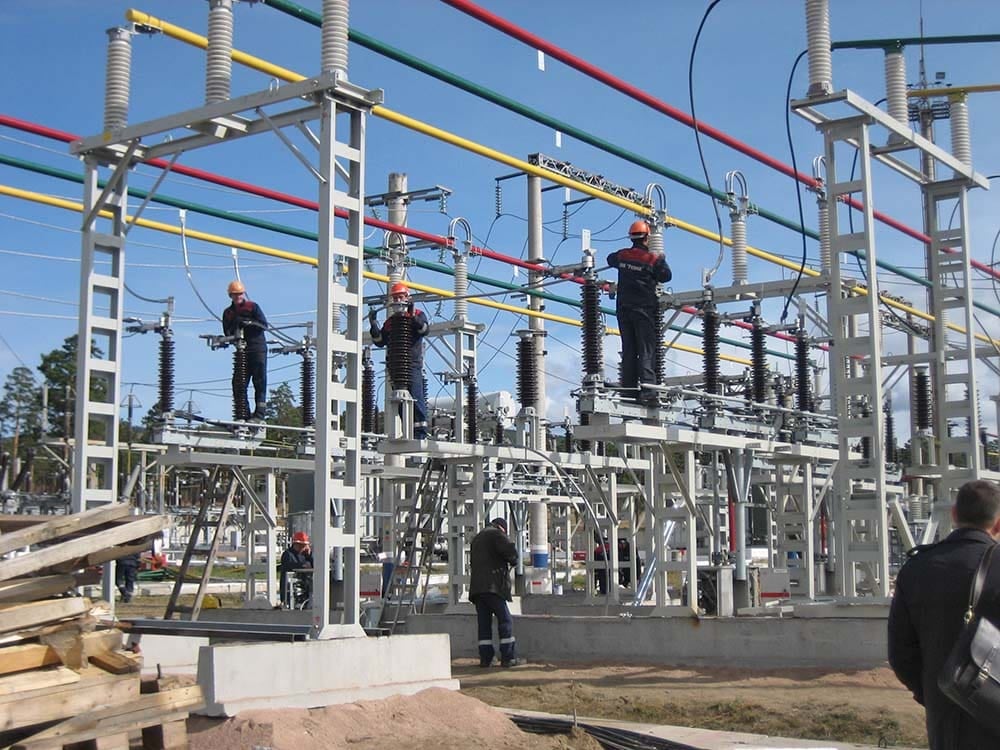

Go back to the Contents Table ↑
2.3.2 Flexible conductors solution
Advantages
- Use of the same material employed for overhead lines
- Bundle Multiple conductors with appropriate diameter to reduce corona effect in ultra-high voltage substations are easy fulfilled
Disadvantages
- The complex layout also for simplex schemes
- Difficult verification of withstanding to electrodynamic forces.
- Busbars overpasses are to be provided
- Considerable environmental impact consequent to three levels of conductors in the substation
- Considerable construction cost.
- Difficulty in employing pantograph and semi pantograph disconnectors
- Difficulty in substation extension.
Figure 8 – Flexible conductors
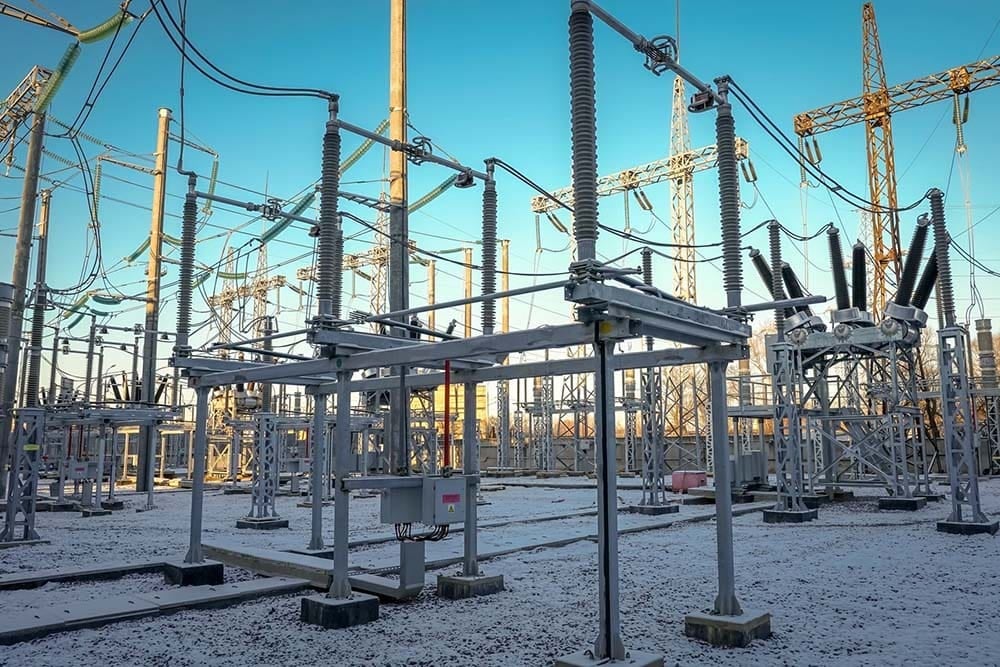

Go back to the Contents Table ↑
3. General Criteria and Rules
3.1 Safety Rules: Definitions
Step Voltage – The difference in surface potential experienced by a person bridging the distance of a human step without contacting any other conductive part [IEEE 80].
Touch Voltage – The maximum potential difference between the accessible earth surface and the dead part which can be touched by a hand of a person standing on the surface [IEEE 81].
Safe Current – The current which can flow through the human body without threat to the life and health of the exposed person [IEC 60479-1, -2]. Maximum step and touch voltages are set to levels that will limit the current flowing through an exposed person to the safe current level.
The proposed methods of service and repair work must be considered in the design of a substation. In most countries, the minimum clearance between live parts and personnel is standardised.
The following parameters are usually defined:
- Minimum height of live parts above the accessible surface.
- Minimum height of the lowest parts of insulators above the accessible surface.
- Minimum horizontal distance between a live part and protective rails, fences, etc.
- Minimum distance between a live part and a human body(or conductive tools) during the work in the substation.
It is also dangerous to handle a long rod with a portable earthing conductor in the vicinity of live parts. Therefore earthing switches are preferable in substations above 145 kV. Portable earthing devices are only used for additional earthing e.g. protection against induced voltage on long busbars.
Suggested reading –
Protective grounding requirements for transmission and distribution lines
Go back to the Contents Table ↑
3.2 Overvoltage and Insulation Levels
All equipment installed in a substation must be designed by taking the rated power frequency voltage of the network into account. The temporary overvoltages at power frequency are often caused by the sudden loss of load or earth faults, switching overvoltages and lightning overvoltages.
In order to determine its capability it is subject to voltage tests as follows:
- Lightning Impulse Withstand Voltage. (1.2/50)
- Switching Impulse withstand voltage (250/2500)
- Power frequency (50 or 60 Hz) (wet and/or dry).
The necessary insulation level depends on the insulation co-ordination, i.e. on the properties of different parts of the network (mainly lines), the protection used against overvoltages (surge arresters ZnO are very effective), on altitude and also on the required reliability of the substation (permissible probability of flashover) and may vary in different parts of the same substation.
Suggested reading – Insulation coordination study for lightning overvoltages in 420 kV power substation
Insulation coordination study for lightning overvoltages in 420 kV power substation
Go back to the Contents Table ↑
3.3 Current Rating and Overcurrents
The instantaneous load flow within a substation depends on the state of the entire electrical network. Usually, a complete network analysis including the development of the network in future is required to determine the nominal values of currents flowing in an individual substation circuit.
It is theoretically possible for maximum current flow to occur with a relatively low total production of electricity in the network. e.g. the supply to a pumped storage power station or when utilising the by-pass facility within a substation.
While designing a substation it is necessary to consider the following two aspects of the effect of current:
- The thermal effect (including induced currents).
- The mechanical effect on conductive items of plant and their support structures.
It may be possible to assign a short-term current rating in excess of the nominal but the analysis leading to this must be to ensure that no “hot spots” (transformers, terminals, busbar support points) are overlooked.
Methods of calculating short-circuit current values are given in IEC Standard 909 and the effects of short circuit current can be evaluated in accordance with IEC Standard 865-1.
Further study – Practical guidance to calculation of prospective short-circuit currents on T&D systems
Practical guidance to calculation of prospective short-circuit currents on T&D systems
Go back to the Contents Table ↑
3.4 Electrical Clearances
It is not possible to test the whole HV installation by corresponding test voltages. Therefore minimum clearances in the air between live parts or between live and dead parts in the air are stated, to obtain the required insulation level in arrangements that have not been tested. As the clearances are stated universally, they must assume the insulation in the worst case of spark-gap with sufficient reliability.
Smaller clearances are permissible if the particular arrangement has been tested by the prescribed insulation test (IEC 60071-1). The values of minimum distances to live parts in the air also depend upon practical experience and therefore, some differences can be found when comparing rules in different countries.
Premium Membership Required
This technical article/guide requires a Premium Membership. You can choose an annually based Plus, Pro, or Enterprise membership plan. Subscribe and enjoy studying specialized technical articles, online video courses, electrical engineering guides, and papers. With EEP’s premium membership, you get additional essence that enhances your knowledge and experience in low- medium- and high-voltage engineering fields.
Check out each plan’s benefits and choose the membership plan that works best for you or your organization.
Limited time offer! – Save 15% on Pro Membership Plan with discount code LRN15










